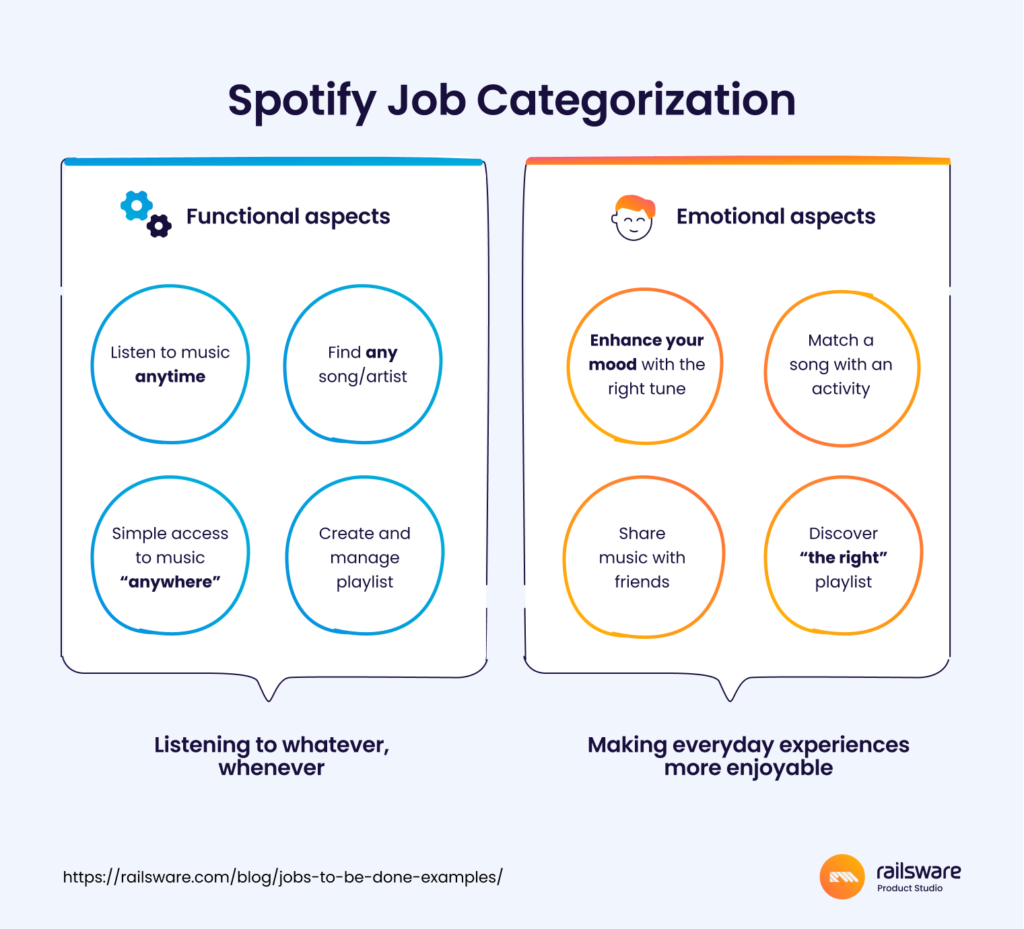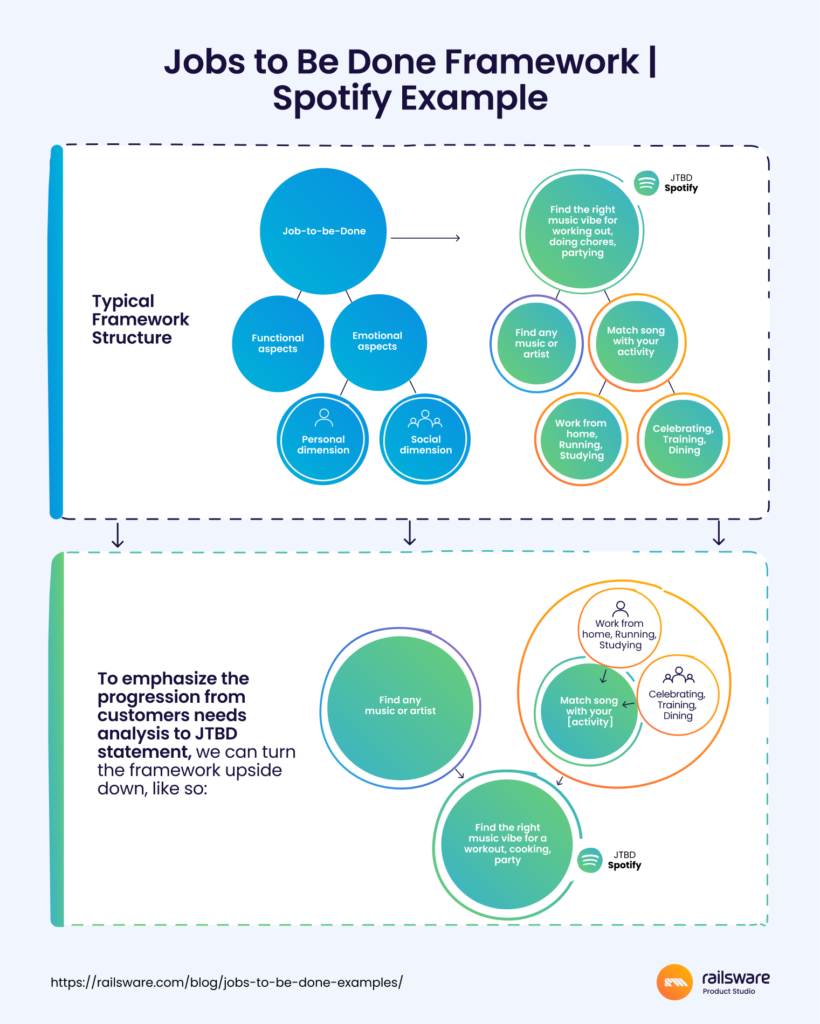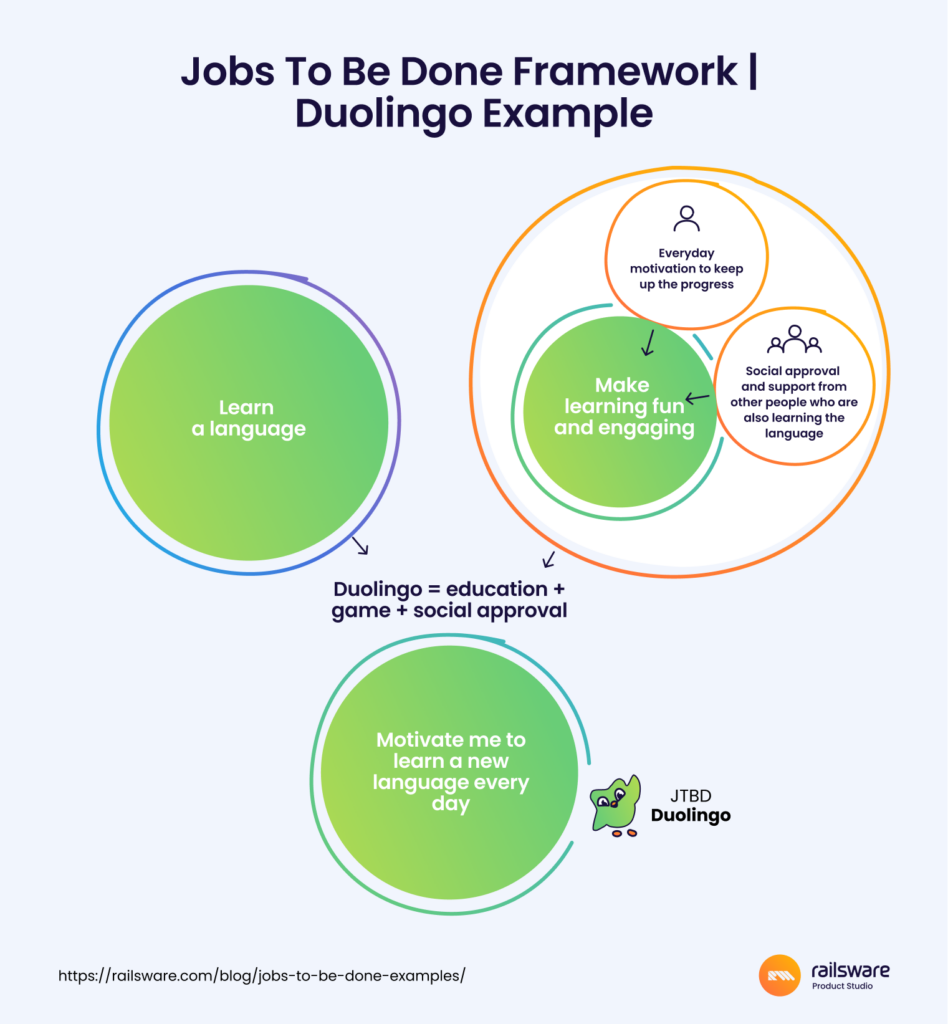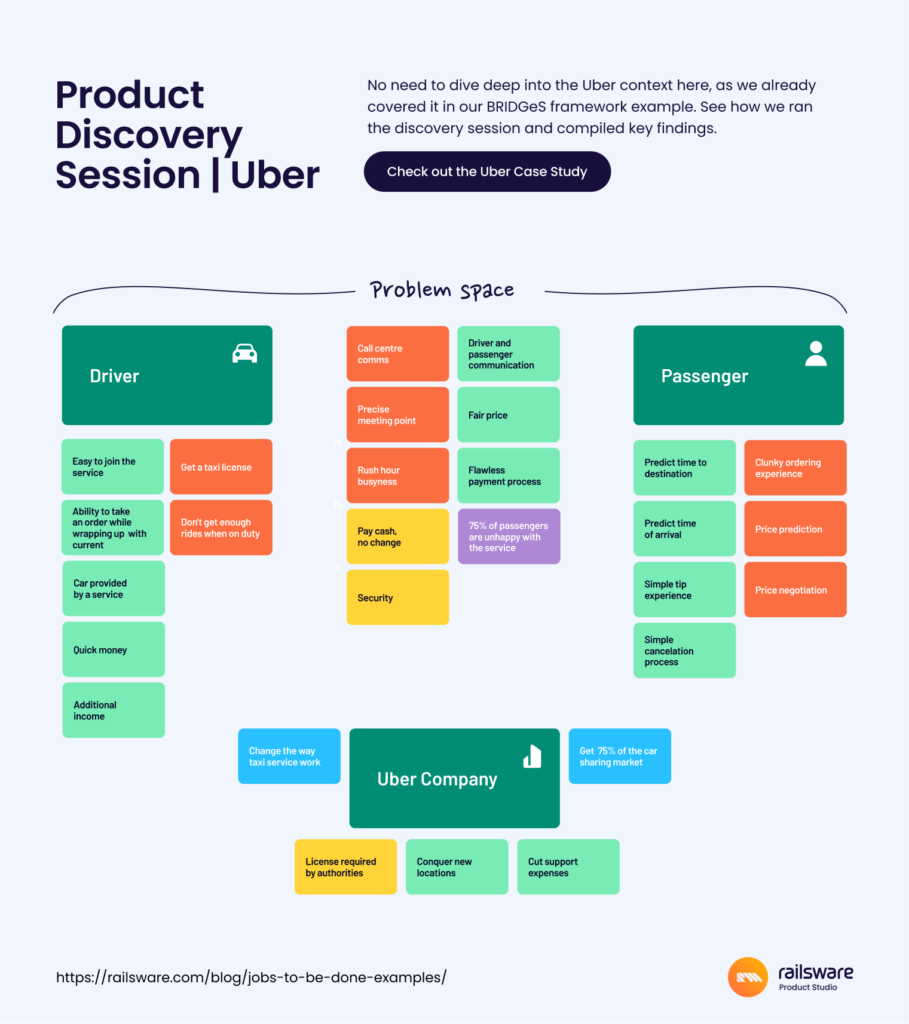Although there are plenty of Jobs to Be Done examples to be found on the web, few focus on real-life cases. So in this post, we’ll use three product examples – Spotify, Uber, and Duolingo – to explain how an adapted version of the framework can be applied to your own new product development process.

Practically speaking, Jobs to Be Done (JTBD) are the specific outcomes a customer wants to achieve by using a product. The aim of the framework is to shift focus from product features to customer goals, prompting product owners and startup founders to ask the question: What is the customer trying to achieve by using our product?
The method itself consists of five phases:
- Market identification
- Jobs identification
- Jobs categorization
- Create job statements
- Opportunities prioritization
But we won’t discuss the traditional Jobs to Be Done approach today. Instead, we’ll offer a new perspective on the framework, and assume that you already know the market you’re building for. We’ll explain the steps behind the most important phases of JTBD: jobs identification, jobs categorization, and creating job statements.
JTBD Framework Examples: Spotify, Uber, Duolingo
Step 1: Job Identification
This first step is all about pinpointing customer needs. There are a few different discovery techniques you can use for this task, such as customer interviews, surveys, and so on. But we’d recommend starting with a product discovery session.
The main question this phase should answer is: What motivates customers to use our product?
We’ll explore this point using Spotify as our first example. But before we jump in, let’s review some stats.
Nowadays people don’t want to buy music, but back in 2008, that was the norm (as were illegal downloads, of course). So when Spotify introduced the concept of renting music that same year, it was a real game-changer. It disrupted the music industry and ensured Spotify’s market fit. As of May 2023, Spotify has over 515 million active users (210 million premium subscribers) and over 11 million artists and creators.
With all that in mind, let’s get back to the question: What motivates Spotify’s target customers to use the product? We ran a discovery session (BRIDGeS is our go-to framework) to investigate further, and found that they want to:
- Listen to music on demand
- Search and find songs/artists
- Find music that fits their current vibe
- Share music with friends
- Brighten up the mood with a song
- Create and manage a playlist
- Share playlists with the community
- Match a tune with a context/activity (discover the right playlist)
Step 2: Job categorization
Now that we’ve defined customer needs, it’s time to categorize them. If you’ve read other articles on the JTBD framework, you’ll have seen this stage split into two parts.
- Main jobs: the core jobs a customer is trying to execute by using your product.
- Related jobs: the smaller, more specific tasks a customer must carry out to accomplish the core job(s).
However, we won’t go into them here. To keep things simple, we’ll only discuss the main (and most crucial) job to be done in our examples. We start by grouping needs into Functional and Emotional. Here’s a quick breakdown of each concept.
Functional: the practical requirements or tasks a product should fulfill.
Emotional: the feelings or desires a product should satisfy.
For the emotional aspect, there’s both a personal dimension and a social dimension. Basically, ‘personal’ refers to the motivations and preferences specific to an individual, while ‘social’ refers to the relationships and social situations that drive product usage.
The aim is to get a more comprehensive picture of why the target customer uses, or ‘hires,’ a product. JTBD doesn’t work well if you’re only looking at customer needs from a problem-solving perspective. Or if you’re just trying to create customer segments. It’s more nuanced than that. See, for most consumers, the ‘job’ isn’t just about ticking a task off their list. There are always emotional factors at play.
So, in the case of Spotify, how might they be grouped?

Step 3: Create job statements
A job statement, sometimes referred to as a ‘desired outcome,’ is a description of the Job to be Done. It’s the single source of truth that the team will refer back to time and time again when designing, developing, and promoting the new product. As you’ll see in the below examples, the JTBD statement serves as a one-sentence summary of the customer’s desired ‘job.’
The framework has a ready-made template for creating statements. It’s a combination of three key elements: (action verb)+(object of action)+(context).
With that in mind, let’s look at some job statement examples for Spotify.
- Find (action verb) the right music vibe (object of action) for a [certain activity] – Working out, partying, cooking, etc. (context)
- Discover new playlists on the go, based on your favorite sounds.
- Have fun and share playlists with friends.
Side note: Although they appear similar, JTBD statements are not the same as user stories.
How to visualize the JTBD framework
As you can see, the Jobs to Be Done process begins with a customer needs analysis and ends with a statement. Yet traditional JTBD framework visualizations represent it backward: Job to Be Done statement → job categorization (functional + emotional) → personal/social dimensions of emotional aspect.
So we propose turning the framework on its head. In the below scheme, the context behind the JTBD statement (emotional and functional needs/motivations) is emphasized. There is a logical progression between our analysis of target customer needs and the identified ‘Job to Be Done.’
Let’s contrast the traditional version with our ‘new’ version:

Like we mentioned earlier, the JTBD framework is first and foremost a needs-finding framework, not an approach to decision-making or problem-solving. This alternative way of visualizing the framework doesn’t minimize the importance of the JTBD statement itself. It simply puts the focus back on the roots of the statement, and reminds us of the underlying motivations and desires of target customers.
With that said, let’s move on to creating job statements for our other featured examples – Uber and Duolingo.
Create JTBD Statement for Uber & Duolingo
Uber
Uber disrupted the taxi industry, but their current service offering extends far beyond that realm. People don’t just associate Uber with getting from place to place anymore. Sister apps, like Uber Eats, have also had a major impact on the food delivery industry.
Here’s what a statement example might sound like for Uber’s core service:
- Book (action verb) a ride through the app (object of action) without communication anxiety (context).
And here are some statement examples for other services/apps:
- Uber Share: Share (action verb) the cost of a ride (object of action) with other people (context).
- Uber Eats: Eat (action verb) takeout food (object of action) without leaving your home (context).

Duolingo
First, let’s offer a little background on the product. Duolingo is easily the most popular language-learning platform in the world, with 550M users that generate $400M in annual revenue.
What does Duolingo’s target customer want to achieve by using the app? From a functional standpoint, they simply want to learn a new language. But from an emotional standpoint, they also want to have a fun and engaging learning experience. Gamified lessons, daily motivation, and social approval/support from other users contribute to this.
The ideal main job statement for Duolingo addresses those core needs. Here’s an example:
Motivate me to learn (action verb) a new language (object of action) every day/without skipping (context).

With each of the job statements we’ve discussed – Spotify, Uber, and Duolingo – the aim has been to condense the customers’ core needs into a single sentence that encapsulates both the functional and emotional aspects.
But as you create your own, remember that the statement must also be timeless. It shouldn’t include references to specific technologies or market trends. As we’ve demonstrated, it should address a problem or task that is universal to the niche you are trying to serve.
For example, in Spotify’s case, people will always be looking for a way to find and play the music they love. Technological advancements, from gramophones to CDs, haven’t changed or quashed this core desire – companies have just found different ways to satisfy it. For Spotify to adapt with the times, they must continue to help people ‘find the right music vibe for X activity.’ Essentially, it’s a value metric that will never expire.
Who should use the JTBD framework and why?
Our perspective on Jobs to Be Done captures the essence of the framework – recognizing, categorizing, and organizing customer needs.
We’d recommend it for:
- Product owners, product managers, or startup founders looking to level up their market research efforts, build customer-centric products, and create better user experiences.
- Developers and UI/UX designers who want to build features that deliver real value to the product and serve the actual needs of users.
- Marketing teams who want to refine their product messaging and design campaigns that appeal to customers’ core needs and motivations.
You can also refer to this article for more tips on how to use Jobs to Be Done in your business.
Wrapping Up
It’s important to remember that JTBD isn’t the right tool for solution-finding. In the above examples, we didn’t try to solve a problem with the framework, we simply used it to better understand the needs of Spotify, Uber, and Duolingo customers.
The process of creating a job statement doesn’t have to be complicated, especially if you start with an ideation session, and leverage the 3-part template. Ultimately, it can help you empathize with your customers, create a sharper product strategy, and get closer to a product-market fit.
